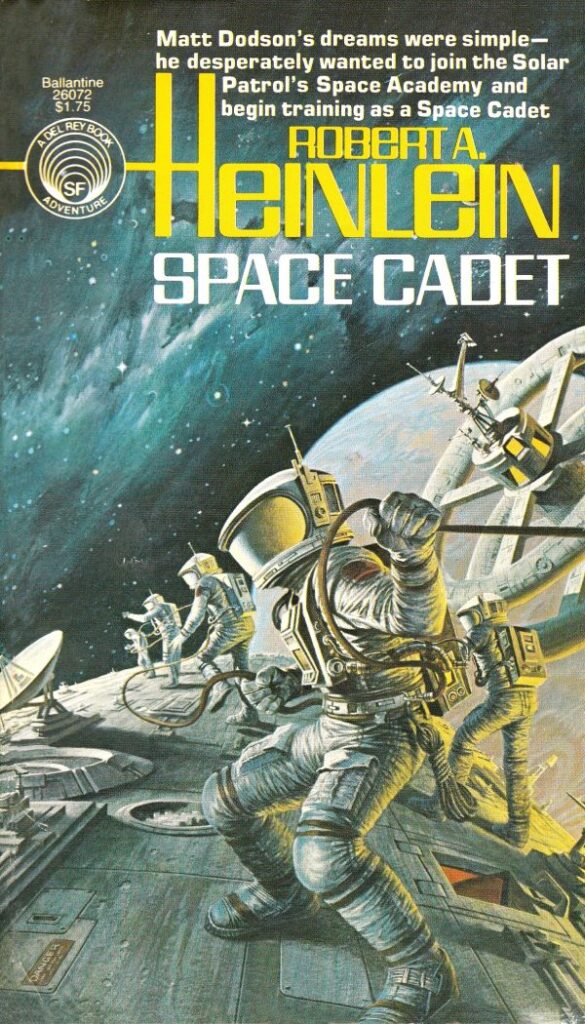Pg. 10
A Book Review by Wendy Van Camp

Heinlein’s Space Cadet
Book Name: Space Cadet
Author: Robert A. Heinlein
First Published: 1948
Robert A Heinlein started his career writing short stories in Astounding Science Fiction, in the 1940s. Many of these short stories and novelettes were later republished as short novels. Heinlein’s first novella, published as a book, was Rocket Ship Galileo. The book was rejected at first because many thought the notion of going to the moon to be too outlandish, but Heinlein persisted with his work. The author moved the book to Scribner’s as his new publisher and thus began a fruitful partnership that would last many years.
Scribner’s required Heinlein to write a “juvenile” novel once a year, to publish at Christmas. The Heinlein Juveniles featured a mixture of adolescent and adult themes. Heinlein was of the opinion that young readers were more sophisticated and able to handle complex themes than people of his time realized. His writing reflected this philosophy.
The first book after his debut novel with Scribner’s was Space Cadet, published in 1948. This book directly influenced the “Tom Corbett, Space Cadet” media empire of the 1950s, including a famous television program, comic books, and radio show. The program showcased an academy where young men trained to join a space patrol that guarded the peoples of the solar system. The characters of the television show and the patrol were incredibly similar to Heinlein’s story.
“Tom Corbett” turned the term “space cadet” into a pop culture phrase, meaning “young men who wished to explore outer space”. Even Jackie Gleason used the term in one of the “Honeymoons” television programs. In the 1960s, this same phrase changed into meaning “tune out of the world due to drugs”. As the world begins its first private space enterprises and NASA runs a “space camp” where young people can learn what it takes to become an astronaut, the term has returned to its original meaning. The TV episodes and radio shows are still available on YouTube. The production values are comical by today’s standards, but in its day, they were state of the art.
Heinlein’s Space Cadet novel begins as Matt Dodson, a young white man of the American Midwest, applies to join the academy of the Solar Patrol. During training, he befriends a group of fellow cadets. William “Tex” Jarman, Oscar Jensen from the planet Venus, and Pierre Armand from Jupiter’s Ganymede. He is also subjected to a roommate. Girard Burke is the unlikable son of a wealthy spaceship builder who enlisted because of his family more than from a desire to be in service.
The young men lift up to the orbiting academy ship, PRS James Randolph to further their training as cadets. As they complete their lessons, Burke washes out and joins the merchant service. The others win assignments to the Aes Triplex, a patrol ship. Their first mission is to search for a missing research vessel in the asteroid belt. They find the ship and its startling conclusions about the destruction of the world that formed the asteroids.
The Captain of the Aes Triplex sends half his crew to man the research vessel in order to return it to Earth for further study. The cadets and the remaining crew continue on in the Aes Triplex. Soon, they receive an urgent message about an incident on the planet Venus. They leave the asteroid belt behind and head back to the inner worlds of the solar system.
From orbit around Venus, the Captain sends Lieutenant Thurlow and the cadets to the planet’s surface. (Heinlein envisioned Venus as being habitable hot, but with a swampy surface. A far cry from what we know is true of the Venusian surface today.) The lander touches down on a sinkhole and the crew must scramble to disembark before the lander sinks and disappears into the mud. Thurlow is comatose and Venusian colonial Jensen assumes command. He decides to contact the sentient native Venusians for aid, but instead, their party is taken captive.
This group of natives had never seen a human before, until their old classmate Burke arrived in his prospecting vessel. Burke took the matriarch of their clan hostage when she refused to sign away her clan’s mineral rights to a deposit of radioactive ore. In retaliation, the natives not only killed Burke’s crew, but took him hostage moments after he sent a message to the patrol for help.
The cadets must work together to convince the matriarch to release her prisoner as they devise a means to return to the human colony located on the south pole of the planet. How they manage is astonishing and is sure to delight anyone with a sense of adventure.
I first read Space Cadet as a young woman in the 1970s. I did not pause to wonder why most of the characters were white and male. It was the standard of the time and female or BIPOC characters as protagonists were few and far between. This unfortunately dates the novel in an unfavorable way. However, the science is tightly woven into the story and propels it forward as only one of the “Big Three” grandmasters of science fiction can do. As I reread the novel in the present day, I still find much to recommend the book despite the obvious cultural flaws.
One of the early scenes I find memorable is when Matt Dodson meets “Tex” Jarman on their way to the academy. Matt gets a call on his cell phone and answers it dutifully. “Tex” had left his own cell phone in his luggage because he didn’t want to be bothered by his family. A common enough scenario in the present day and an indication of the personalities of the characters. However, what a current reader might forget is that cell phones were not invented when Heinlein wrote the book and would not come into being until almost 50 years later. So, did Heinlein predict the cell phone . . . or did the engineers get the idea for the design from Heinlein? We may never know.
Although this book was written before the civil rights movement, when the page excluded non-white characters, Space Cadet explores the theme of diversity via conversations about the far-flung make-up of the members of the Patrol and in the description of the Venusian conflict. The natives of Venus are described as primitive, but the author reveals they have developed a high level of technology of their own. I also appreciated that their leader was female, a small nod to some equality between the sexes even with the censorship of the day. While diversity is not discussed in quite this manner today, in the time of its writing, it was considered to be thought provoking.
Of all the authors that I read growing up, Robert A. Heinlein was one of the most influential on me as a science fiction writer. His dead-on prediction of many scientific gadgets that we take for granted today, such as flat screen television, cell phones, and other everyday items is astounding. I’ve taken the time to learn his references and his universe’s timeline which makes the reading experience richer, both for scientific knowledge and for historical context. There is a saying among science fiction writers that “Heinlein was here first.” For good reason. His stories have shaped the genre in ways that are incalculable.
If you want to become familiar with science fiction in general, the Robert A. Heinlein “juveniles” should be on your reading list. They are not just for kids.
List of Robert A. Heinlein’s Juvenile Novels:
Rocket Ship Galileo, 1947
Space Cadet, 1948
Red Planet, 1949
Between Planets, 1951
The Rolling Stones, 1952
Farmer in the Sky, 1953
Starman Jones, 1953
The Star Beast, 1954
Tunnel in the Sky, 1955
Double Star, 1956 — Hugo Award, 1956
Time for the Stars, 1956
Citizen of the Galaxy, 1957
Have Space Suit—Will Travel, 1958 — Hugo Award nominee, 1959
Starship Troopers, 1959 — Hugo Award, 1960
Editor’s Note: The great science fiction writer and editor John W. Campbell described Space Cadet as being a “corking good yarn.” Agreed. Wendy has been nominated for the Pushcart Prize by this publishing house.
